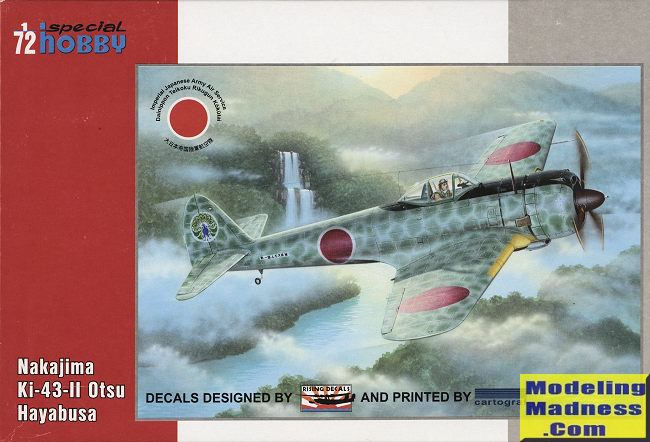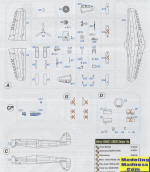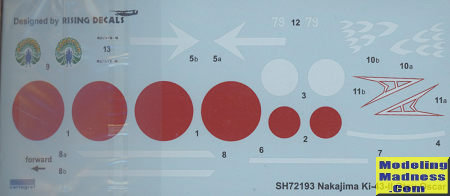
Special Hobby 1/72 Ki-43-II otsu Hayabusa
| KIT #: | SH 72193 |
| PRICE: | $25.00 or so delivered |
| DECALS: | Four options |
| REVIEWER: | Scott Van Aken |
| NOTES: |

| HISTORY |
The Ki-43 is to the Japanese Army what the A6M was to the Japanese Navy during WWII. It was the first modern, low winged, retractable landing gear fighter of either service. Both were designed with maneuverability as the major factor in their design. The result was that the aircraft were lacking in other areas that were considered just as important to other powers. They did not have adequate armor protection, and the Ki-43 had rather weak armament of twin 12.7mm machine guns, even compared to the A6M which also had two 20mm cannon. The Ki-43 also had very good range, but this was a result of the lightweight airframe construction and lack of heavy things like armor plating and self-sealing fuel tanks.
Initially the Army did not like the Ki-43 as it was not as maneuverable as the lighter and smaller fixed undercarriage Ki-27. However, it did have superior range and the war in China required a longer ranged fighter. Despite not being considered maneuverable enough, Allied pilots who attempted to dogfight with the Ki-43 soon found themselves in trouble. Fortunately, the lack of heavy armament of the Oscar often saved the foolish Allied pilots. Despite the known shortcomings of the Ki-43, the type was continually modified and produced even after the type was obsolescent. Many were expended in suicide attacks near the end of the war.
| THE KIT |
 For
decades the Hasegawa Ki-43 was considered to be the best in this scale.
While not a bad kit, it is showing its age and this one has a lot more
detail. Of course with that detail comes smaller parts and more of them.
Also part of the deal is a bit more guesswork in terms of where bits go.
For
decades the Hasegawa Ki-43 was considered to be the best in this scale.
While not a bad kit, it is showing its age and this one has a lot more
detail. Of course with that detail comes smaller parts and more of them.
Also part of the deal is a bit more guesswork in terms of where bits go.
The cockpit is nicely done with a two part seat that fits onto a floor piece along with the control stick and rudder pedals. There is nice sidewall detail and a few bits to attach to it. The main instrument panel attaches to one of the fuselage halves before closing them. The instructions call for you to paint the interior a dark olive green, but I'm betting these planes were Nakajima Interior Green, a sort of greenish yellow color available in some paint brands. Once you close the fuselage halves, you attach the horizontal stabs and the three piece wing. No holes to open for the pylons as there aren't any holes for these items.
With that done the engine cowling, which is a center and upper piece with two side pieces, gets the engine face trapped within. The prop is glued to the front of the engine unless you modify both to allow it to spin. This is the 'late' -II which, unlike the -I and 'early' version, has exhaust that point to the rear adding a bit of thrust. The kit also includes the later individual ejector exhaust, though that is marked as do not use. The engine oil cooler is three parts and you have a headrest assembly to place aft of the cockpit before attaching the separate windscreen and canopy.
The kit does provide pylons, anti-sway braces and fuel tanks for under the wings, but there is no placement guide on the lower wings, just a drawing that shows each pylon 26mm from the centerline. Landing gear and main gear doors are nicely done and while the tail gear is shown attached early in the assembly, I'd leave it off until as late as possible to keep from breaking it.
Instructions are well drawn with detail images as
needed. Four very nice options are provided. One is the box art plane in
unpainted metal with dense green 'giraffe' spots on it. This 64 Sentai plane is
a presentation aircraft as you can see from the fin marking. Next, with a
squiggly 'mirror wave' camo over unpainted metal is a standard 64 Sentai plane
which, like the first option, is from later in 1944. The next two are in dark green over
unpainted metal with the first of these being from the 264th Sentai in New
Guinea in early 1944. The other is with the 63rd Sentai also at Hollandia in New
Guinea during early 1944. All options have yellow wing leading edges and black
upper fuselage anti glare areas which will need to be painted. Note that on the
unpainted metal areas, all the flight control surfaces are in a grey-green
primer. Decals are very nicely printed.
first option, is from later in 1944. The next two are in dark green over
unpainted metal with the first of these being from the 264th Sentai in New
Guinea in early 1944. The other is with the 63rd Sentai also at Hollandia in New
Guinea during early 1944. All options have yellow wing leading edges and black
upper fuselage anti glare areas which will need to be painted. Note that on the
unpainted metal areas, all the flight control surfaces are in a grey-green
primer. Decals are very nicely printed.
| CONCLUSIONS |
Back to the Main Page Back to the Previews Index Page
Back to the Previews Index Page